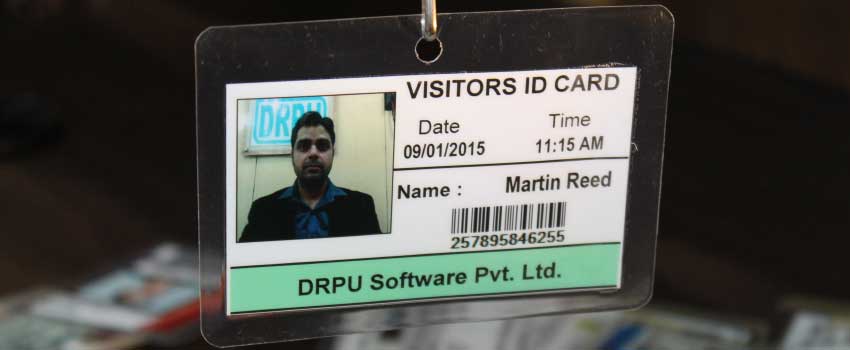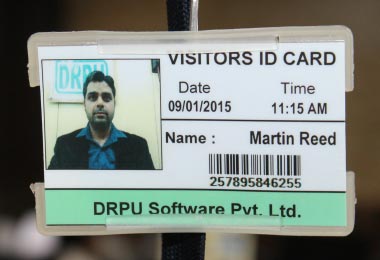Issuing Process of Visitor ID Cards
The process of issuing visitor ID cards involves several steps, including registration, verification, data collection, and card production.
-
I. Pre-Registration:
The process of issuing visitor ID cards often begins with pre-registration, which allows the host organization to gather essential information about the visitors before their arrival. Pre-registration can be done through various methods, such as online forms, email, or phone calls. The pre-registration form typically includes details like the visitor's full name, contact information, purpose of visit, date and time of arrival, and duration of stay. This preliminary step helps streamline the check-in process and ensures that the necessary arrangements are made for the visitors' arrival.
-
II. Check-In and Registration:
Upon arrival, visitors are required to check-in at a designated area, such as a reception desk or security checkpoint. The registration process involves verifying the visitor's identity, collecting additional information if necessary, and assigning a unique visitor ID or badge. The following steps are commonly involved in the check-in and registration process:
-
Identity Verification: To maintain security, visitors are typically required to provide a valid form of identification, such as a government-issued ID card, driver's license, or passport. The staff at the check-in point verifies the visitor's identity by comparing the provided identification document with the pre-registered information of the visitor or by conducting an on-site identification checking process.
-
Data Collection: Once the visitor's identity is verified, additional information may be collected to enhance security and facilitate record-keeping. This data may include the purpose of the visit, the name of the person or department being visited, any specific access requirements. Some organizations may also require visitors to sign an acknowledgment form or agree to specific terms and conditions.
-
Visitor ID Badge/Pass: After the registration process, the visitor is typically issued an ID badge or pass. This badge serves as a visual identification and provides access rights based on the visitor's authorized areas. Visitor ID badges may include essential details like the visitor's name, photo, unique ID number, date of visit, and expiration date. The badges can be temporary, valid only for the duration of the visit, or reusable for frequent visitors.
-
-
III. Access Control and Monitoring:
Visitor ID cards are closely tied to access control systems, which regulate entry and restrict access to certain areas within an organization. These systems ensure that visitors are granted access only to authorized locations, while also providing a means to monitor their movements. The following elements are commonly involved in access control and monitoring:
-
Access Permissions: Depending on the purpose and requirements of the visit, visitor ID cards can be programmed to grant access to specific areas, such as lobbies, meeting rooms, or certain floors of a building. Access permissions are typically encoded within the ID card or associated with the visitor's profile in the access control system.
-
Security Measures: Visitor ID cards often incorporate security features to prevent unauthorized duplication or tampering. These may include holograms, UV markings, barcodes, magnetic stripes, or embedded microchips. Such security measures enhance the card's integrity and make it more difficult to counterfeit.
-
Monitoring and Logging: Access control systems generate logs and records of visitor movements, allowing administrators to monitor their activities. This information can be invaluable in case of security incidents or investigations. Visitor data collected during the registration process can also be used for statistical analysis or visitor flow optimization.
-
-
IV. Card Return and Data Management:
Once the visit is concluded, visitors are typically required to return their ID cards or badges to the designated area. Card return helps ensure that all visitors have officially checked out and reduces the risk of unauthorized access. Concurrently, data management is an essential aspect of the visitor ID card issuance process. The following aspects are involved in card return and data management:
-
Card Retrieval: Visitors may be asked to return their ID cards at a designated location or to authorized personnel before leaving the premises or organization. This step helps prevent unauthorized access attempts by the individuals and ensures that the organization's inventory of ID cards remains accurate.
-
Card Reusability: In the case of visitor ID cards designed for multiple uses, such as for frequent visitors or contractors, the cards can be retained for subsequent visits, provided they remain valid and within the defined expiry period. This allows for efficient reissuance and reduces the overall cost of visitor management.
-
Data Retention: The visitor data collected during the registration process may be retained by the organization for a certain period. Data management practices should comply with data protection guidelines, ensuring the secure storage and proper disposal of visitor information once it is no longer needed.
-
In Summary, The process of issuing visitor ID cards involves several stages, from pre-registration to card return and data management. Each stage plays a crucial role in ensuring security, managing access, and maintaining an efficient record of visitors. By implementing a comprehensive visitor management system, organizations can enhance their security protocols, streamline visitor registration, and effectively control access to their premises.
Validity Period of Visitor ID Cards
The validity period of visitor ID cards can vary depending on the specific policies and regulations of the organization or institution issuing them.
-
Visitor Registration Systems: The utilization of visitor registration systems, whether manual or automated, can impact the validity of ID cards. Automated systems allow for efficient registration and tracking of visitors, enabling organizations to issue ID cards with specific validity periods based on predefined rules. These systems may also integrate with access control systems to automatically deactivate visitor cards once their validity expires.
-
Risk Assessment: Some organizations conduct risk assessments to evaluate the potential threats associated with specific visits. Based on the outcome of the assessment, they determine the appropriate validity period for visitor ID cards. Higher-risk visits, such as those involving sensitive areas or confidential information, may necessitate shorter validity periods to minimize potential security risks.
-
Businesses and Offices: In many businesses and office settings, visitor ID cards are typically valid only for the duration of the visit. When individuals visit these establishments, they are issued temporary visitor ID cards that are valid only for the duration of their stay within the premises. Once the visit is over, the visitor ID card becomes invalid, and individuals are expected to return it or discard it.
-
Events and Conferences: For events, conferences, or trade shows, visitor ID cards are usually valid for the duration of the specific event. These ID cards grant access to attendees during the event and often include personalized information such as the attendee's name, organization, and a unique identifier. Once the event concludes, the visitor ID cards become obsolete and are typically no longer valid for future events.
-
Educational Institutions: Visitor ID cards issued by educational institutions, such as schools or universities, may have varying validity periods. Some institutions may issue visitor ID cards that are valid for a single day or a specific period, such as a semester. These ID cards allow visitors to access certain areas of the institution or attend specific events. After the validity period ends, the visitor ID card may need to be renewed or returned.
-
Government Facilities: Visitor ID cards for government facilities, such as courthouses, military installations, or government offices, typically have specific validity periods. The duration of validity is usually determined by security protocols and the nature of the visit. For example, a visitor ID card for a single-day visit to a courthouse may only be valid for that particular day, while a visitor ID card for a more extended stay or recurring visits may have a longer validity period.
Important Note: It is essential to note that the specifics of visitor ID card validity can vary significantly depending on the issuing authority and the purpose of the visit. Organizations or institutions that issue visitor ID cards usually have their own policies in place to regulate their usage and validity. Therefore, it is crucial to consult the respective organization or institution to obtain accurate information regarding the validity period of visitor ID cards in a particular context.
In conclusion, the validity period of visitor ID cards is influenced by several factors, including the type of visit, organizational policies, security considerations, legal requirements, visitor registration systems, and risk assessments. By tailoring the validity duration based on these factors, organizations can strike a balance between security measures and visitor convenience. The ultimate goal is to ensure the safety and well-being of all individuals within the premises while facilitating legitimate access and fostering positive guest experiences.
Download and Install Visitor ID Card Software
Security Features should be Included in a Visitor ID Card
When designing a visitor ID card, it's important to consider various security features to ensure the card's authenticity and prevent unauthorized access. Here are some key security features that can be included:

Background pattern: Use a complex, difficult-to-replicate background pattern that includes intricate designs, colors, or microprinting.
Holograms: Incorporate holographic images or foils that change appearance when viewed from different angles, making it harder to counterfeit.
Watermarks: Integrate watermarks into the card design, visible when held up to light, adding an extra layer of authenticity.
Guilloche patterns: Include intricate, fine-line patterns that are challenging to reproduce accurately.
Microprinting: Add tiny, difficult-to-reproduce text or images that require magnification to read.
Holographic or tamper-evident seals: Apply holographic or tamper-evident seals to the card's surface that will show signs of tampering if removed or altered.
UV ink: Use special ultraviolet (UV) ink that is invisible under normal lighting but becomes visible under UV light. This can help detect tampering or counterfeiting attempts.
Lamination: Apply a protective layer of lamination to the card, making it harder to alter or tamper with.
Photo identification: Include a high-resolution photograph of the visitor on the card to confirm identity visually.
Variable data printing: Utilize individualized data printing, such as unique visitor names, assigned access areas, or visit duration, to discourage reuse or unauthorized use of the card.
Barcodes or QR codes: Incorporate machine-readable barcodes or QR codes that can be scanned for quick verification and tracking of visitor information.
Signature panel: Provide a designated area for visitors to sign their name, enabling further verification when compared to a handwritten signature.
RFID/NFC chips: Embed Radio-Frequency Identification (RFID) or Near Field Communication (NFC) chips within the card, allowing for secure access control, tracking, and authentication.
Magnetic stripes: Include magnetic stripes that can be encoded with visitor information and read by compatible card readers, providing an additional layer of verification.
Smart card technology: Use smart cards with embedded microprocessors capable of securely storing and processing data, enabling advanced encryption and authentication methods.
Expiration date: Clearly indicate an expiration date on temporary ID cards to limit their validity period.
Visitor badges: Issue temporary badges that are easily identifiable, distinct from permanent cards, and designed for short-term use.
Self-expiring materials: Utilize self-expiring materials that change color or display the word "VOID" after a specific timeframe, discouraging reuse.
In conclusion, By incorporating a combination of these security features, visitor ID cards can enhance authentication, deter counterfeiting, and provide a higher level of security for access control and identification purposes. It's important to regularly review and update these features to stay ahead of evolving security threats and technologies.

